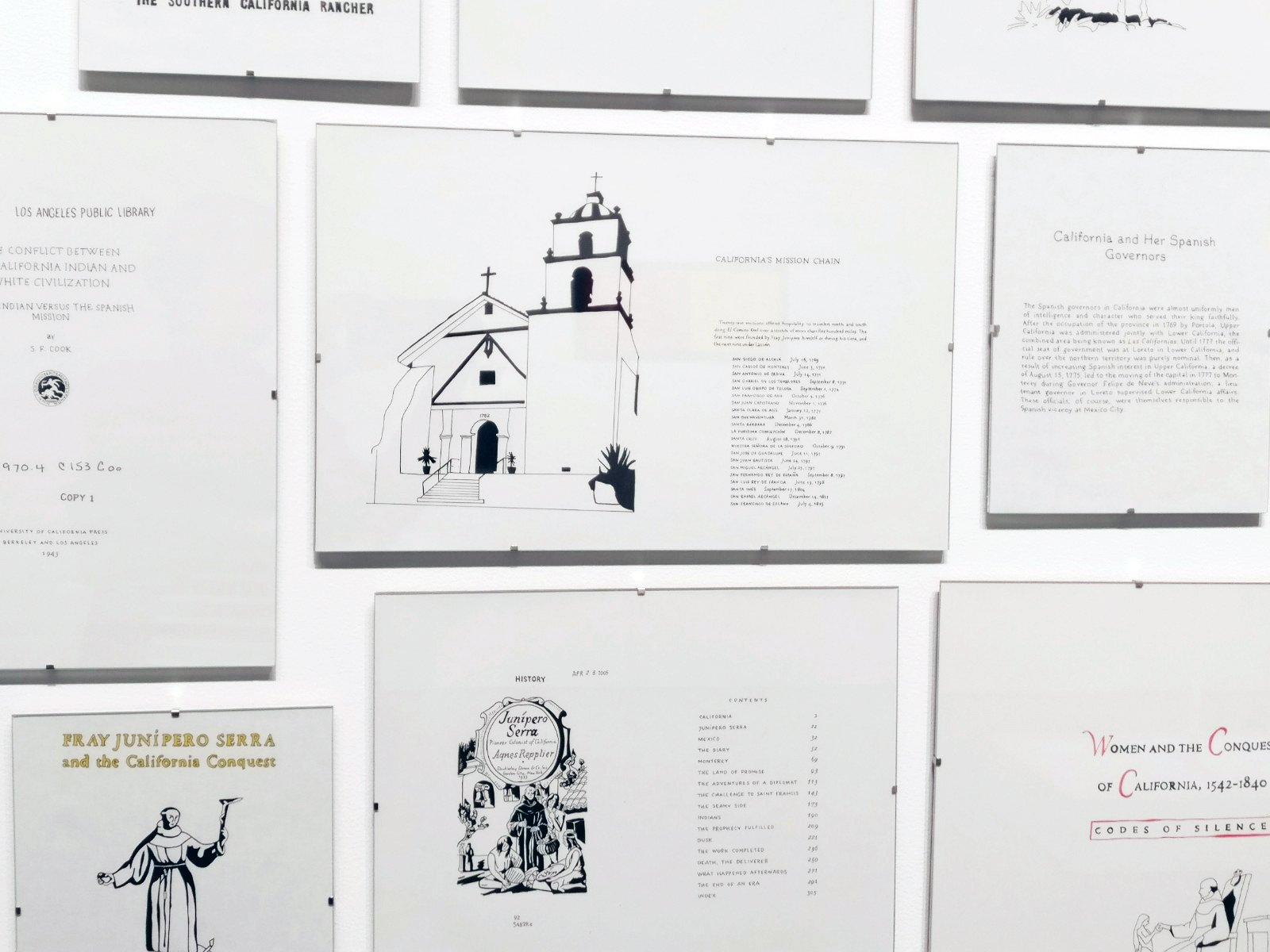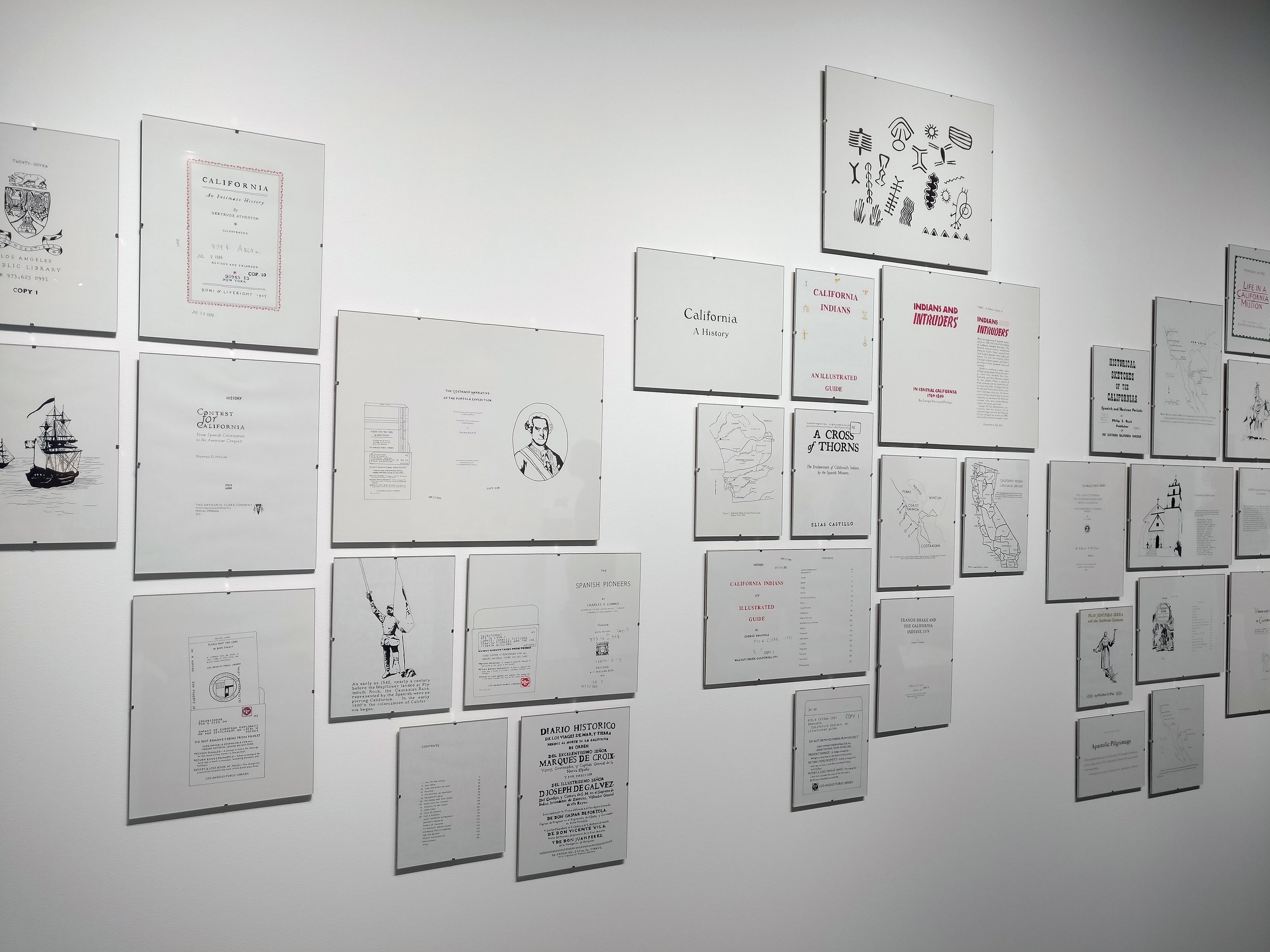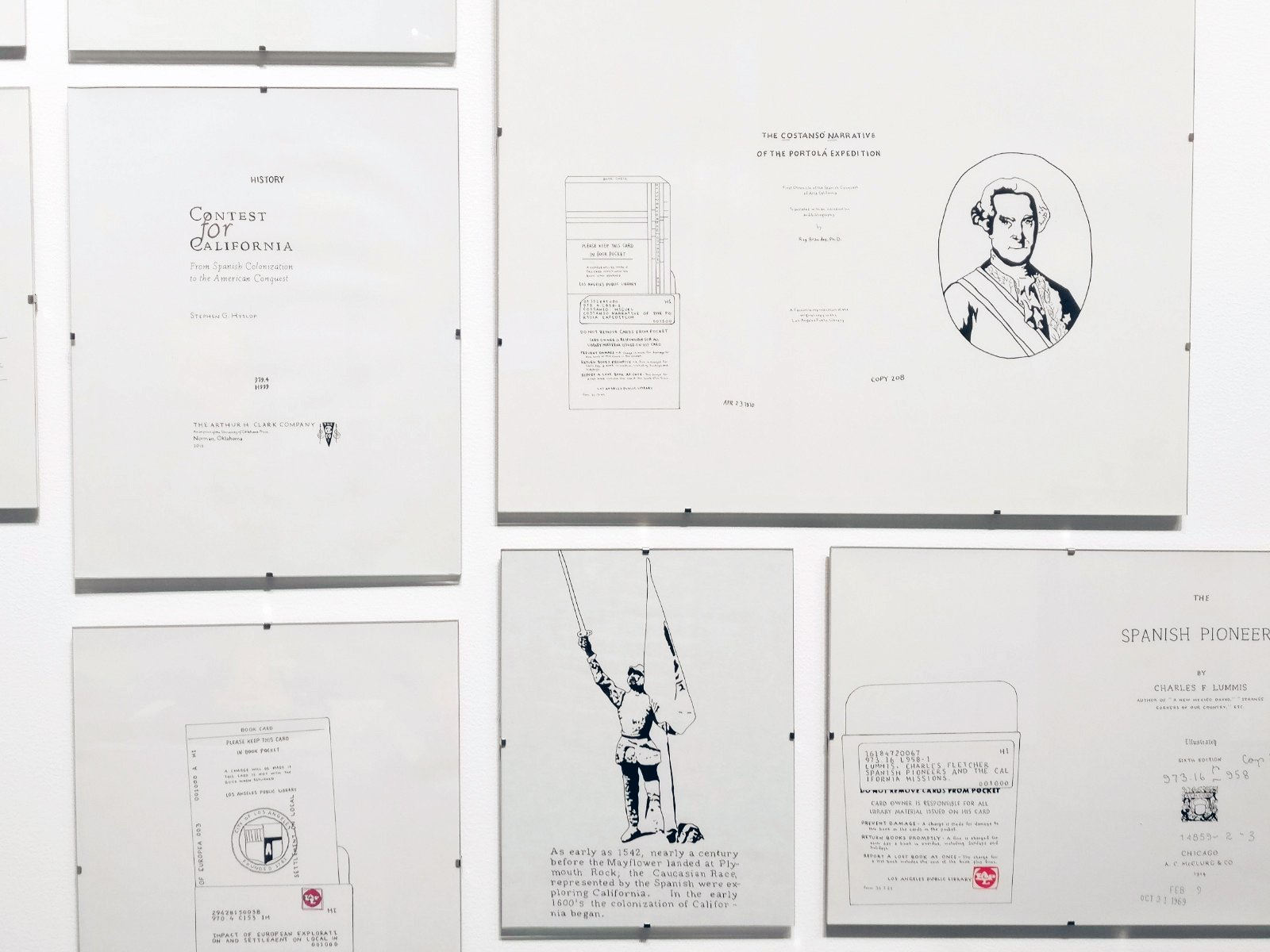“Imaginary Homelands : the artworks of Monica Rodriguez” by Marcelo Guimarães Lima
A text is first of all a visible object, whether in printed form or as the original preparatory manuscript, in whatever medium or format it is composed. The hand that writes, directly on paper or on a screen, is guided by the eye, and the eye by the ear, that is, by an inner voice (mostly virtual in our world of developed literacy) in a kind of “transcendental” synesthetic process (sound, vision, touch) in which the senses are able to figure (taking this word in the proper meaning of shaping a plastic form or symbol) what pertains to signification and its related mental (ideal, abstract) processes.
In her series Californiana, artist Monica Rodriguez hand draws printed texts, book covers, title pages, and printed images. Printed texts and printed matter have a history within the history of modern and contemporary art, and also, more specifically, the book as subject. In the late 1960s, expatriate American artist Ron Kitaj created, in his London studio, a series of silkscreen prints from photographs of covers from his personal book collection. Inspired by Walter Benjamin’s essay on book collecting, the artist credited his identification to the Jewish dimension of Benjamin’s texts as having provided the inspiration that led to his further explorations of Jewish authors, and from that to the artist´s reflection on his own Jewish identity grounding and explaining his art practice and aesthetic concepts. Themes of identity and culture, reflections on the conditions of diaspora, assimilation, minority status, memory, identification, and otherness guided the self-understanding of the painter at the time.
Kitaj´s book cover series, the transposition of printed matter into artworks, has been related, in connection to the artist’s rather personalistic and somewhat self-absorbed perspectives and statements, to the genre of the still-life within the actual and symbolic space of the artist studio. Since Courbet up to the Cubists and beyond, the artist studio provided subjects, the place, context and occasion for artistic self-reflection, formal experimentation, stylistic and visual language innovations in late 19th and early 20th century art.
Printed matter as such furnished Picasso with ready-made visual elements incorporated and mimetized in his original cubist paintings and collages, of seminal importance for the visual arts in the period and beyond. Flatness, geometric forms, the use of gray tonalities, subdue color harmonies, letters and numerals as plastic elements, among various characteristics of Picasso´s importantly innovative artworks came to represent stylemes of modernity and pointed the way to an expansion of aesthetic and artistic methods, concepts and practices.
In contrast to Ron Kitaj’s book cover series, in which the American artist utilizes a printing medium to reproduce printed matter in a kind of “tautological” strategy of re-production or self-reproduction, Monica Rodriguez´s Californiana works both relate and differentiate the general allographic elements of printing to the essentially autographic universe of drawing.
Question of identity are also central ideas in Monica Rodriguez’s works. However, beyond subjective aspects of purely personal, and hence limited, private experience, her focus is the public and historical contexts of our self-understanding as members of social and historical collectivities, approached from a critical historical point of view. Symbolic, imaginative elements in her works are informed by a conceptual perspective where the aesthetic and the political, that is, creation of forms and discourses of power, are aspects of one and the same subject and artistic orientation. In her artistic praxis, the studio space opens itself to the external world, while external spaces of collective experience and reflection, such as, for instance, the public library, are appropriated by the artist as an extended art studio.
As pertain to the artist´s sensibility and vision, grounded on the language, the complexities of the historical context and experience of her native Puerto Rico, a land caught between de facto colonial condition and persistent national affirmation, and on her specific approach to our contemporary context, it is the collective dimension of memory and imagination, approached with the tools of historical knowledge and documentary research, that supports and sustains her individual artistic procedures, methods and perspectives. Here, the present, the locus of memory, is considered both as the provisional “synthesis” or “passage” between a reflected and re-appropriated past and a projected alternative future, and as the decisive ground for the creation and preservation of meaning,
The understanding of the present as history can disclose the paradox of our everyday experience of time, our temporal horizon and destiny as, on the one hand, the time creatures we are and know ourselves to be as finite beings, and on the other, the one-dimensional apprehension of our own experiences within the confinement of the “here and now”. A confinement that our quotidian, mundane horizon imposes, leading to a kind of “narcissistic”, restricted, alienated consideration of the present, our time (ourselves), as a kind of ¨absolute”, in fact, if not in concept, as causa sui.
To express the historical dimensions of the present it is to fight against collective amnesia and consequent loss of identity. Loss of identity is also expressed by reified representations of self and other. In the vagaries of “identity politics”, images and concepts created and experienced “here and now”, grounded in the present reality and context, are considered in fact as a-temporal, beyond the actual flow and transformations of time. The result is a constructed image of the past where the past is devoid of its proper dimension and specific identity, a past that simply mirrors the present. In this way, a mythical past emerges, a past projected from the limitations of the present, a time that never was.
In what pertains to memory and identity, here also the function of art is to “de-familiarize” assumed, inherited, projective, and unexamined images and perspectives, to challenge our habitual, conventional, reiterative emotional and conceptual responses to our world.
On Image and Language
By recreating book pages and covers by hand, as in the composed artwork titled Californiana, Monica Rodriguez performs at the same time a kind of structural analysis that “reverts back” to the imagistic sources of all writing. She exposes what lays at the “hidden” core of our all too familiar universe of written communication. In the genesis of writing, historically and in the developmental process of children, the practice of drawing prepares the codification of the set of graphic elements that compose a given writing system. Imbricated at first, drawing and writing become separated processes as language and the processes of linguistic representation develop and contribute, in our context of early socialization and schooling, to modify the mental universe and behavioral contexts of the developing child, as it did for patterns of communication, memory and thinking in the development of literate civilizations. And yet, image and writing -image and language- can never be separated once and for all.
As our digital world of communications redesigns linguistic representation and refashions the relations between word and image, we observe our linear, discursive universe being transformed, recreated, and re-encoded into a multidimensional, multi-layered type of “pluriverse” that both reveals the specificities of our previous categories and practices of thinking, acting and communicating and adumbrates new connections, amalgams, relations within new multidimensional spaces and related new temporalities in the making. In Monica Rodriguez’ Californiana , drawing is indeed a type of re-encoding practice.
Touch and Vision, Hand and Mind
In the drawings of Monica Rodriguez the two dimensional surface of a paper sheet becomes a transformed, redefined space where multidimensional perspectives and narratives, texts, images, maps, manuscripts, diagrams, can coalesce and recreate personal and public approaches on history and culture, by way of surface patterns, by the creation of graphic circuits and linear rhythms as a kind of a string of Ariadne, the connecting thread within the labyrinth of the here and now, and amid the Tour of Babel of contemporary conceptual and ideological perspectives.
The simplicity, that is, the economy of means in these artworks (as in the myth, in Ariadne’s linear stratagem and device facing the complexities of the labyrinth’s mythical paths and mythical architecture) and the artist’s strategic initiatives, the connecting threads to the understanding of the labyrinth of ongoing cultural and historical transformations, signals the workings of a productively “synthetic” vision and imagination.
The “re-productive” process in her works shows that mimesis, as a kind of “second production” after a first production taken as subject, it is not a secondary or simply subordinated, purely reproductive, a “tautological” production, but it is the exploration of productivities (virtualities) embedded in the source, an active examination of production using the mental and material tools of drawing, the elementary gesture of creating handmade marks on a surface, by way of traces that are both material and ideal on ideal and material surfaces. It is in fact, an examination of human creativity considered as a dynamic and multidimensional process. A process whose telos is not just what is being produced as such, but the product as a link in an ongoing mutual, associated development of producer and product, subject and object in mutual transformations.
The angular constructions of typography are recreated in the drawings of Monica Rodriguez by the rhythmic, flowing, undulating movements of the writing/drawing hand and its characteristic pressure marks and ductile textures, actual and implied or suggested, on the paper surface. As the drawn lines and marks refashions the printed forms, they signal towards a pictorial archaeology of the written sign and typography, expressing both the necessary interrelations and constitutive differences between image and language. Relations and differences that can be properly understood within a logic of the supplement pertaining to both form and meaning. In the act of drawing, the hand emerges as an organ of knowledge in and by itself.
The Island of California
In the records of the conquest of New Spain and the explorations and early occupation of territories in the north of present day Mexico by the Spanish conquistadores, the Baja California territory was at first believed to be an island. A belief stated by early explorers and represented in maps.
Of the various proposed hypothesis on the origin of the name California, a commonly accepted explanation is a literary source: the 16th-century chivalric romance by Garci Rodríguez de Montalvo, Las Sergas de Esplandián. The then popular Spanish novel described a fictional island named California, ruled by mighty Queen Calafia.
Californiana by Monica Rodriguez takes as its point of departure the imaginative geography of the Island of California and expands it in the context of a geography of memory, a geography of language and images, the mapping and re-mapping of a poetic territory of layered times in topological relations, that is, manifold relations of ever-changing relative proximities and distances across time and space. Californiana is at the same time a personal geography of public memory and a narrative of time shifts, of mutant identities, of a diaspora within ancestral lands, of language and memory as homeland, of a foreign condition within proper spaces of identity and belonging.
As displayed on the exhibition space as a collection of drawings of various sizes arranged on a wall in a overall composition, Californiana shows a kinship to mural art, comic books and graphic novels and related forms of visual/ textual narratives. The narrative in this case focus on documentary sources, books, and essays, on diverse literary and historical records and studies about the Spanish conquest, the pre-history of American occupation, and the fate of vanquished, conquered, and subordinated indigenous population. California is a territory of perennial conquest, of imperial wars and oppression, of layered strata of colonial and neo-colonial processes, of symbolic and material erasures of peoples, languages, and cultures, of clandestine resistance and subordinated amalgams and survival strategies. Californiana´s documentary imagination and strategies bring to the fore and reactivates the traces of an essential, that is, structural and living past.
By collecting, representing, and reproducing available printed sources, books and documents from public collections, a discreet and effective sense of irony colors Monica Rodriguez series. These ordered pages, patiently and attentively recomposed, with their luminous white surfaces and their hand made marks suggest, or rather, they gently point out that hidden in plain sight, in public archives and libraries, are facts, images, narratives and reflections that reactivated and represented can contribute to our own understanding of our place and times, with their own questions and challenges. That is, if we want to look for, to gather, to organize and display, if we want to know.
Monica Rodriguez (b.1980, San Juan, Puerto Rico) examines the history and impact of colonialism on the political, economic and social conditions of the Caribbean. Her work often takes up archival documents in order to question the ways in which dominant historical narratives of power are constructed and represented. Byjuxtaposing and connecting historical documents that shere-createsinto drawings, photographs and videos herwork promptsnew spaces for critical thinking where the past is no longer a fixed set of facts, but a tool that helps us imagine alternative possible futures.Rodriguez received a BFA from the Escuela de Artes Plásticas y Diseño de Puerto Rico (2005), an MFA from the California Institute of the Arts, California (2011) and she was a fellow at the Whitney Independent Study Program, New York (2012 –2013). Rodriguez has exhibited her work internationally, group exhibitions includeTEA Tenerife Espacio de las Artes, Santa Cruz,Spain(2021); Institute for Contemporary Art at VCU, Richmond, VA (2020); Museo de Arte Contemporaneo de Puerto Rico, San Juan, PR (2019); Armory Center for the Arts, Pasadena, CA(2019); LACE Los Angeles Contemporary Exhibitions, Los Angeles, CA (2019); Glass Curtain Gallery, Columbia College, Chicago, IL (2018); 19th Contemporary Art Festival Videobrasil, Sao Paulo, Brazil(2015); among others. Rodriguez lives and works in Los Angeles, California.



